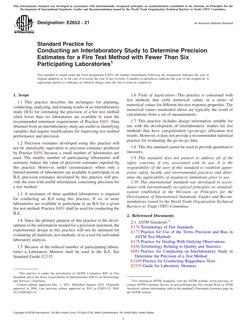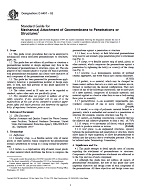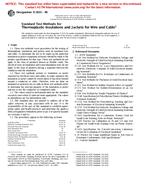1.1 This test method describes the apparatus and procedure for evaluating the pull-off strength of wet lay-up or pultruded (shop-fabricated) Fiber Reinforced Polymer (FRP) laminate systems adhesively bonded to a flat concrete substrate. The test determines the greatest perpendicular force (in tension) that an FRP system can bear before a plug of material is detached. Failure will occur along the weakest plane within the system comprised of the test fixture, FRP laminate, adhesive and substrate.
1.2 This test method is primarily used for quality control and assessment of field repairs of structures using adhesive-applied composite materials.
1.3 This test method is appropriate for use with FRP systems having any fiber orientation or combination of ply orientations comprising the FRP laminate.
1.4 This test method is not appropriate for use as an “acceptance“ or “proof“ wherein the FRP system remaining intact at a prescribed force is an acceptable result.
1.5 Pull-off strength measurements depend upon both material and instrumental parameters. Different adhesion test devices and procedures will give different results and cannot be directly compared.
1.6 This test method can be destructive. Spot repairs may be necessary. The test method will result in an exposed cut FRP section; repair methods must consider the potential for moisture uptake through this cut section.
1.7 Prior to the installation of some adhesively bonded FRP systems, the substrate concrete must be patched (often to replace lost concrete volume). This test method is not appropriate for determining the pull-off strength of the FRP from the patch material. An additional test method is required to determine the pull-off strength of the patch from the substrate concrete. Throughout this standard, “substrate“ is understood to mean the concrete or concrete patch material to which the FRP is adhered.
1.8 The values stated in either SI units or inch-pound units are to be regarded as standard. Within the text, the inch-pound units are shown in brackets. The values stated in each system are not exact equivalents; therefore, each system must be used independently of the other. Combining values from the two systems may result in nonconformance with the standard.
1.9 This standard does not purport to address all of the safety concerns, if any, associated with its use. It is the responsibility of the user of this standard to establish appropriate safety and health practices and determine the applicability of regulatory limitations prior to use.
Product Details
- Published:
- 06/01/2009
- Number of Pages:
- 6
- File Size:
- 1 file , 220 KB


